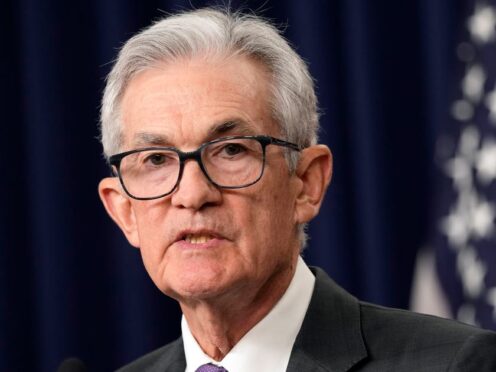
Federal Reserve officials will likely reduce their benchmark interest rate later this year, chair Jerome Powell said, despite recent reports showing that the US economy is still strong and inflation picked up in January and February.
“The recent data do not … materially change the overall picture,” Mr Powell said in a speech at Stanford University, “which continues to be one of solid growth, a strong but rebalancing labour market, and inflation moving down toward 2% on a sometimes bumpy path.”
Most Fed officials “see it as likely to be appropriate” to start cutting their key rate “at some point this year,” he added.
In his speech, Mr Powell also sought to dispel any notion that the Fed’s interest-rate decisions might be affected by this year’s presidential election campaign. The Fed will meet and decide whether to cut rates during the peak of the campaign, in July and September.
Though inflation has cooled significantly from its peak, it remains above the Fed’s 2% target. And average prices are still well above their pre-pandemic levels — a source of discontent for many Americans and potentially a threat to President Joe Biden’s re-election bid.
The recent pick-up in inflation, though slight, has led some economists to postpone their projections for when the Fed will begin cutting rates.
Rate cuts would begin to reverse the 11 increases the Fed carried out beginning in March 2022, to fight the worst inflation bout in four decades. They would likely lead, over time, to lower borrowing rates for households and businesses.
Many economists now predict that the central bank’s first rate cut will not come until July or even later. That expectation has fuelled some speculation on Wall Street that the Fed might end up deciding to delay rate cuts until after the presidential election. The Fed’s November meeting will take place on November 6-7, immediately after Election Day.
Former president Donald Trump has called Mr Powell “political” for considering rate cuts that Mr Trump has said could benefit Mr Biden and other Democrats.
Mr Powell was first nominated to be Fed chair by Mr Trump, who has said that, if he is elected president, he will replace Mr Powell when the Fed chair’s term ends in 2026.
In his speech on Wednesday, Mr Powell noted that Congress intended the Fed to be fully independent of politics, with officials serving long terms that do not coincide with elections.
“This independence,” Mr Powell said, “both enables and requires us to make our monetary policy decisions without consideration of short-term political matters.”
The Fed chair’s remarks follow several reports showing that the economy remains healthy, largely because of solid consumer spending. Yet that strength could make it harder for the Fed to achieve its goal of slowing inflation to its 2% target. Annual inflation ticked up in February to 2.5%, according to the central bank’s preferred measure, though that was down sharply from its peak of 7.1%.
When they met two weeks ago, Fed officials forecast that they could cut their benchmark rate three times this year. Still, nearly half the 19 policymakers pencilled in just two or fewer rate cuts.
Strong economic growth could diminish the likelihood of a Fed rate cut later this year for two reasons. One is that steady hiring and brisk consumer spending can lead companies to raise prices and thereby worsen inflation.
The other reason is that a healthy economy reduces the need for the Fed to cut rates, which tends to stimulate growth. Typically, the central bank reduces its key rate when growth stumbles and companies start cutting jobs. Mr Powell and other officials have underscored that as long as the economy remains healthy, they can take time to assess the path of inflation and ensure that it is headed back down to their 2% target.
Last week, a government report showed that consumer spending accelerated in February, and prices rose faster than is consisted with the Fed’s inflation target for the second straight month.
“On inflation, it is too soon to say whether the recent readings represent more than just a bump,” Mr Powell said. “Given the strength of the economy and progress on inflation so far, we have time to let the incoming data guide our decisions on policy.”
In remarks this week, some other Fed officials reiterated their expectations for three quarter-point rate reductions this year, while also underscoring that such cuts would depend on inflation slowing from the January and February readings.
“I think three is still reasonable, but it’s a close call,” Loretta Mester, president of the Federal Reserve’s Cleveland branch, told reporters on Tuesday.
Still, Raphael Bostic, president of the Atlanta Fed, said earlier on Wednesday that he envisions just one interest rate cut this year, likely in the final three months of the year.
They are among the 12 policymakers with a vote on the central bank’s interest rate decisions this year.

Enjoy the convenience of having The Sunday Post delivered as a digital ePaper straight to your smartphone, tablet or computer.
Subscribe for only £5.49 a month and enjoy all the benefits of the printed paper as a digital replica.
Subscribe